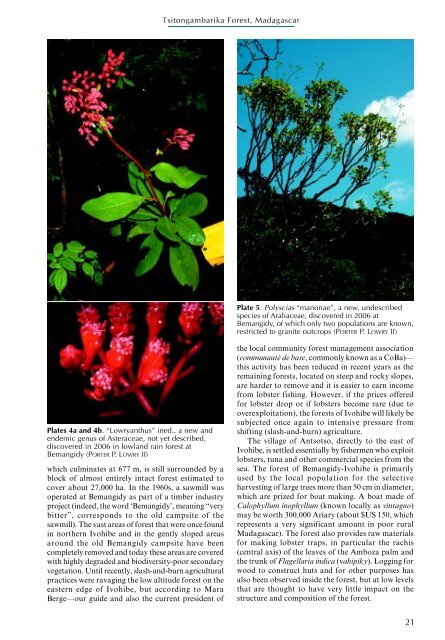TSITONGAMBARIKA FOREST, MADAGASCAR - BirdLife International
TSITONGAMBARIKA FOREST, MADAGASCAR - BirdLife International
TSITONGAMBARIKA FOREST, MADAGASCAR - BirdLife International
You also want an ePaper? Increase the reach of your titles
YUMPU automatically turns print PDFs into web optimized ePapers that Google loves.
Plates 4a and 4b. “Lowryanthus” ined., a new and<br />
endemic genus of Asteraceae, not yet described,<br />
discovered in 2006 in lowland rain forest at<br />
Bemangidy (PORTER P. LOWRY II)<br />
which culminates at 677 m, is still surrounded by a<br />
block of almost entirely intact forest estimated to<br />
cover about 27,000 ha. In the 1960s, a sawmill was<br />
operated at Bemangidy as part of a timber industry<br />
project (indeed, the word ‘Bemangidy’, meaning “very<br />
bitter”, corresponds to the old campsite of the<br />
sawmill). The vast areas of forest that were once found<br />
in northern Ivohibe and in the gently sloped areas<br />
around the old Bemangidy campsite have been<br />
completely removed and today these areas are covered<br />
with highly degraded and biodiversity-poor secondary<br />
vegetation. Until recently, slash-and-burn agricultural<br />
practices were ravaging the low altitude forest on the<br />
eastern edge of Ivohibe, but according to Mara<br />
Berge—our guide and also the current president of<br />
Tsitongambarika Forest, Madagascar<br />
Plate 5. Polyscias “manonae”, a new, undescribed<br />
species of Araliaceae, discovered in 2006 at<br />
Bemangidy, of which only two populations are known,<br />
restricted to granite outcrops (PORTER P. LOWRY II)<br />
the local community forest management association<br />
(communauté de base, commonly known as a CoBa)—<br />
this activity has been reduced in recent years as the<br />
remaining forests, located on steep and rocky slopes,<br />
are harder to remove and it is easier to earn income<br />
from lobster fishing. However, if the prices offered<br />
for lobster drop or if lobsters become rare (due to<br />
overexploitation), the forests of Ivohibe will likely be<br />
subjected once again to intensive pressure from<br />
shifting (slash-and-burn) agriculture.<br />
The village of Antsotso, directly to the east of<br />
Ivohibe, is settled essentially by fishermen who exploit<br />
lobsters, tuna and other commercial species from the<br />
sea. The forest of Bemangidy-Ivohibe is primarily<br />
used by the local population for the selective<br />
harvesting of large trees more than 50 cm in diameter,<br />
which are prized for boat making. A boat made of<br />
Calophyllum inophyllum (known locally as vintagno)<br />
may be worth 300,000 Ariary (about $US 150, which<br />
represents a very significant amount in poor rural<br />
Madagascar). The forest also provides raw materials<br />
for making lobster traps, in particular the rachis<br />
(central axis) of the leaves of the Amboza palm and<br />
the trunk of Flagellaria indica (vahipiky). Logging for<br />
wood to construct huts and for other purposes has<br />
also been observed inside the forest, but at low levels<br />
that are thought to have very little impact on the<br />
structure and composition of the forest.<br />
21

















